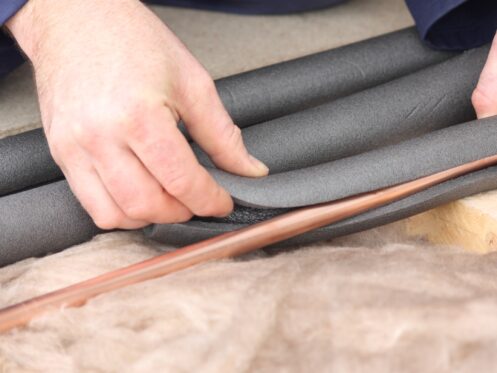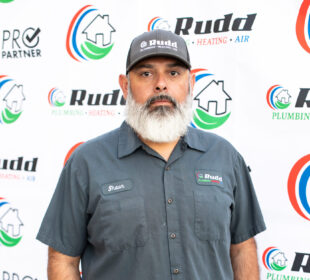Frozen pipes can be a difficult issue to manage in cold areas, but in places like Charleston, where the temperature is milder, they can still be an issue. In fact, if you are not used to your pipes freezing, the chances of them bursting are higher, especially when temperatures drop below 20 degrees Fahrenheit for a few days.
Typically, the weather will need to be at this temperature for at least six hours for the pipes to freeze. If you notice that the weather is going to be bitter for a day or two, here are some tips to follow to ensure that your pipes don’t burst.
Keep Cabinet Doors Open
Pipes are typically located in an exterior wall of your home, and these can freeze easier than pipes that are not. Bathroom pipes and sink locations can vary, but most kitchen sinks are set against an outer wall.
If you simply open the cabinet doors under the sink, some of the heat from inside your home will surround the pipes and keep them a little warmer. This small amount of additional warmth can be the difference between the pipes freezing and healthy pipes. Pipes that remain frozen for about three days have a higher chance of bursting.
Open Faucets for Running Water
Water that is moving takes much longer to freeze than water just sitting in the pipes. One way to ensure that the water does not freeze is to turn the faucets on slightly. This only needs to be a drip or a slow trickle because even slow movement within the plumbing system will keep your pipes from bursting. We recommend dripping hot and cold water to ensure all pipes are flowing!
Warm the Outside of the Pipes
Some homes naturally have colder areas that can be dangerous to pipes. Unfinished basements often have pipes that carry water, and these areas tend to be colder than the rest of the home. You can easily warm up the pipes, even if just slightly, by using warm air. This can be a small space heater or a hair dryer. Perhaps you will even need to blow the air directly into the pipes underneath the sink.
Utilize Heat Tape
Heat tape is another useful tool that can warm your pipes so they do not burst. Heat tape has a design that wraps around the pipes in your home. When the tape is in place, electricity warms the tape as well as the pipe that the tape surrounds. Tape installation may be more beneficial when done a certain way. At Rudd Plumbing Heating and Air, we strive to prepare you with the best information to help keep your pipes from busting in frigid temperatures.
Keep a Consistent Temperature Inside
To avoid this kind of problem, keeping the indoor temperature at a stable and warm level is essential. Our recommendation is to keep indoor temperatures around 65 degrees Fahrenheit using your thermostat during both day and night, but you can set it as low as 55 degrees. This ensures that the pipes are able to warm up uniformly to prevent them from freezing, even when the night’s outdoor temperatures are at their coldest.
While the inside-cabinet area won’t be quite as warm as the main areas of your home, warming the living areas should help regulate pipe temperatures. Drafts from doors and windows can increase cooling, so to ensure that you have a uniform level of heat, you can utilize draft stoppers.
Replace Old Pipes
A sure sign of older pipes is loud noises. The pipes’ shifting as water flows through them causes this noise. When the water pressure is too high, these pipes can weaken further and eventually break. Ideally, the water pressure in your home should be between 20 and 50 psi for optimal performance. Weakened pipes can burst with water pressure that exceeds this, but at Rudd Plumbing Heating and Air, we can easily adjust the pressure and ensure that all of your pipes are secure.
Damaged pipes also have this same weakness. Aging pipes that have corrosion are likely to burst when the water pressure is too high. If you visibly see any corrosion on the pipes, you may wish to consider replacing them completely. Hard water speeds up the corrosion process, so softening your water may be an option to extend the life span of your pipes. Once the corrosion is past a certain point, we may suggest repiping the system to ensure that your water is safe.
Insulate Pipes
Pipes found in your crawl spaces, attic, garage, basement, or along the exterior walls are the most likely to freeze. This is because these spaces tend to have the poorest insulation against outside temperatures. To prevent freezing and to maintain temperatures within the pipes themselves, we suggest insulating the pipes against the lower temperatures.
When insulating pipes, you have many options. For example, pipe sleeves, which we can install, are great insulators that will prevent pipe freezing. Another effective option, which we mentioned above, is electrical heat tape, which can wrap the pipes. Fiberglass, mineral wool, rubber, and foam are all great materials for regulating pipe temperatures. Here’s a quick breakdown of the features of some of these materials:
Fiberglass
Made from woven glass strands, fiberglass is an excellent option for keeping in heat when insulating pipes. This is due to a higher thermal resistance, which prevents heat loss. Fiberglass is particularly effective when insulating copper pipes. This material is also fire-resistant and comes in both tube and wrap format.
Mineral Wool
Like fiberglass, mineral wool is a great insulator that will prevent thermal siphoning when wrapping pipes. It’s also a largely fire-resistant material that’s able to withstand temperatures up to 650 degrees Fahrenheit.
Insulating Foam
Insulating foam is typically sprayed directly onto the pipes, especially in areas that are hard to reach. As it cures, it expands, increasing its heat retention. Effectively, foam insulation provides a thick wall that protects the pipes from the freezing temperatures outside. This is a great option for also filling in gaps and cracks around pipes.
Rubber Insulation
Rubber insulation comes in a variety of formats; for example, the most popular are tape-based rubber insulation and pipe wraps. This insulation, like insulating foam, is a good choice for filling in cracks and crevices around pipes, and closed-cell insulating will also keep your pipes dry, which is also useful when the temperature goes below freezing.
Contact a Reliable Professional
At Rudd Plumbing Heating and Air, we have been providing plumbing services in Charleston since 2014. We also provide heating and cooling services, so we can easily and quickly take care of all of your HVAC needs!
Call Rudd Plumbing Heating and Air with any questions or to make an appointment for a pipe inspection today!

